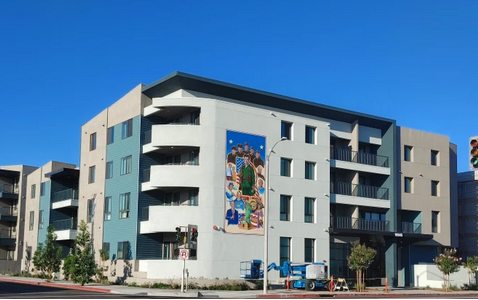A 53 unit affordable housing project for veterans and families in downtown El Monte had its grand opening today. Plaza Ortiz is named for deceased local Army vet Corporal Ysabel Arredondo “Mac” Ortiz. Ortiz lost his life in the Korean War in 1950 at the brutal Battle of Chosin Reservoir. His remains (and dozens of others) were returned to the U.S. in 2019 after President Trump’s summit with Kim Jong Un.
Ortiz lived mere blocks from Plaza Ortiz at Barrio Grenada. Grenada was one of several labor camp communities set up in El Monte during segregation. Latino farmworkers who were not allowed to buy houses in the city limits built rustic homes in these barrios, which eventually evolved into suburban neighborhoods, still known by their old names to longtime locals.
Ortiz’s younger brother Manuel is the caretaker of his legacy. A lot about Mac is unknown because he died three years before Manuel was born, and they had different mothers. However, the information he does know paints a picture of life for Latinos in El Monte.
“Mac was born on Granada Street itself. I did find on the 1940 census where they lived, that it was at 133 and a half [Grenada Street]” says Ortiz. “Back in those days, living conditions were not any better than they are now. But people had to choose like we do now, what we want to do in life, and that’s the situation. He didn't finish high school. He went into the service at a very young age. And he got killed at a young age. He had just turned 19.”
Barrio Grenada is now the south end of the Valley Mall, and the homes behind it. The site of Plaza Ortiz was a city-owned trolley center beside the Metrolink tracks, off Tyler Avenue and Valley Boulevard. It was built with city, county, state, and private funding by the Cesar Chavez Foundation.
Paul Chavez, Cesar Chavez' son and president of the Foundation, said at the Plaza's opening dedication that "the residents of this community should know, and they will know, who Mac Ortiz was."
The Cesar Chavez Foundation’s Vice President of Housing and Economic Development, Alfredo Izmajtovich, tells Streetsblog that El Monte is a highly appropriate place for an affordable housing project.
“Cesar was trying to create a situation where people, farmworkers, could have dignity in the workplace and be able to be part of the community and access all the things that are available to Americans,” says Izmajtovich. To that end, he says providing affordable housing is a critical part of the Foundation’s mission ”so people don't get priced out of the community. It's all part of the idea of trying to reinforce that people should be allowed to participate in the American dream, and Latinos historically, and farmworkers, were shut out a lot of times from that.”
Units at Plaza Ortiz are available to income-eligible veterans through referrals from Veterans Affairs. Income-eligible families can put in applications for the waiting list with the Foundation, and then be entered into a lottery to live there. Manuel Ortiz says there’s widespread need for this kind of housing. “Everything's unaffordable now. Everything is too expensive for people. We're not careful, the majority of people are going to wind up homeless.” Here are El Monte's median home prices on Zillow.
Plaza Ortiz will offer additional services for it's residents. The Cesar Chavez Foundation is partnered with L.A.-based nonprofit Step Up to provide “onsite social services… to people experiencing serious mental health conditions, and persons who are experiencing chronic homelessness.” The Foundation also touts an afterschool learning center for children who live at the Plaza.
The front of Plaza Ortiz 1 features a mural of veterans and first responders. The central figure is Mac Ortiz, but the five soldiers behind him are the Flores family of veterans, who came from another barrio, Medina Court. They attended the grand opening as well.
Top L-R: Frank Flores, Richard Flores
Bottom L-R: Vincent Flores, Eugene Flores
Credit: Chris Greenspon/Streetsblog
"My brother's legacy will live on for generations to come," said Ortiz's other brother Joe, thanking the building developer. Izmajtovich tells Streetsblog that the Foundation is currently developing similar affordable housing projects throughout the SGV in Pomona, Montebello, and Baldwin Park.
The Cesar Chavez Foundation was told of Mac Ortiz’s story by La Historia, the local museum dedicated to the residents of the barrios. Thanks to La Historia for connecting us with this story. Read more by the author about Mac Ortiz here






